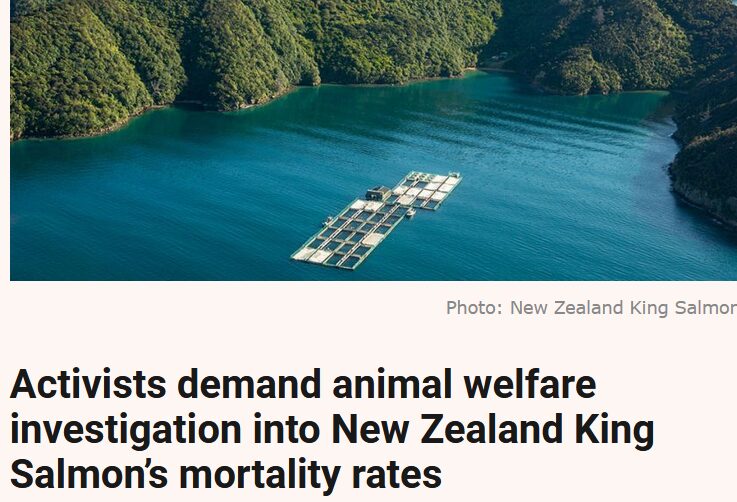 Í meðfylgjandi frétt segir frá kröfu dýraverndarsamtaka á Nýjasjálandi um rannsókn á skelfilegum laxadauða í sjókvíum þar við land.
Í meðfylgjandi frétt segir frá kröfu dýraverndarsamtaka á Nýjasjálandi um rannsókn á skelfilegum laxadauða í sjókvíum þar við land.
Það er sama hvar sjókvíaeldi á laxi er stundað í heiminum þá er meðferðin á eldisdýrunum fyrir neðan allar hellur.
Dauðinn í sjókvíunum við Noreg hefur aldrei verið verri en í fyrra. Sama sagan var í fyrra hér við land og nú þegar er ljóst að þetta ár verður enn þá verra.
Hrikalegur fjöldi laxa drapst vegna vetrarsára og bakteríusýkinga í Dýrafirði fyrir vestan í byrjun árs. Á Austfjörðum hafa Laxar fiskeldi og Fiskeldi Austfjarða tilkynnt norsku kauphöllinni, þar sem móðurfélag fyrirtækjanna er skráð, um slátrun á fjórðu milljón eldislaxa vegna blóðþorraveirusmits á undanförnum dögum.
Sú tala er á við að ígildi alls íslenska villta laxastofnsins myndi þurrkast út á hverju ári næstu 60 til 70 ár.
Sjókvíaeldi á laxi er óboðleg aðferð við matvælaframleiðslu. Það skaðar umhverfið og lífríkið og níðist á eldisdýrunum.
Salmon Business fjallar um málið:
“New Zealand King Salmon’s mortality rates have been branded an “animal welfare disaster” after the company’s annual report showed a 42% rate for farmed salmon.
“Mortality rates this high are completely unacceptable and it warrants a full animal welfare investigation,” Anna de Roo, the campaigns manager for animal rights group SAFE, said in a press release.
New Zealand King Salmon had to dump 1,269 tonnes of dead salmon after a mass mortality situation occurred, putting significant strain on the company’s finances and causing its debt to grow.
The company, which describes itself as a “pioneer in marine salmon farming” in the region is facing criticism from animal rights groups, who stated that “if this was happening to cows or pigs, there would be investigations and prosecutions.”
Following the situation at New Zealand King Salmon, the activists are calling for officials to introduce a code of welfare that offers salmon protection under the Animal Welfare Act.
Read also: New Zealand King Salmon’s shares lost over 70 percent of their value during disastrous year
“Unusually early elevated seawater temperatures were a major factor behind high mortality rates, with the marine heatwave during summer associated with a La Niña event. It resulted in a $20.8 million (€12.7 million) negative impact on profitability from high fish mortalities,” said New Zealand King Salmon CEO Grant Rosewarne said announcing the year-end financial results last April.
Rosewarne added that the company has intensified its efforts to identify and counter the factors that aggravate the climate effect on its salmon. One strategy is to fallow three farms in the Pelorus Sound, where the company traditionally produced salmon year-round. It was in those farms where the bulk of mortalities occurred in the summer. They will instead be used as nursery when they’re fallowed, the company said.
The company has the unfortunate moniker of being the worst performer on the New Zealand stock exchange, having seen its stock price drop by over 70 percent to a mere NZD $0.20 (€0.12) over the past 12 months.”
